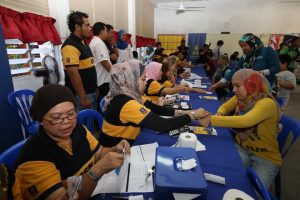
(MMO) – Contrary to the “general understanding” that the Indians are poorer, the community’s mean income of RM5,646 is still RM500 more than what the Bumiputera make.
When 28-year-old middle class entrepreneur Kamil Abu Bakar was asked for his views about the government’s latest programme to enhance the Malay community’s economic well-being, the Bumiputera Economic Transformation Roadmap 2.0, he shrugged.
To Kamil, who runs a profitable barber shop in Setiawangsa, one of the capital city’s many Malay middle class enclaves, his affluent surrounding as well as his ability to compete in the city’s tough business environment proved that the Malays can be independent.
“The Malays are doing very well already… from small to medium to serious corporate business, you can see the Malays or the Bumiputera are deep in the game so if you ask me, this whole subsidy or incentive thing given out in the name of Bumiputera will only make our race look weak and dependent,” he added.
Subsequently, Kamil was asked to comment about the Malaysian Indian Blueprint (MIB), which, like the BTER 2.0, is yet another form of race-based affirmative action aimed at improving the social mobility of a particular community through targeted financial assistance and other “positive discriminatory” policies like employment quotas.
Kamil felt the blueprint was justified. “Well, the Indians are poorer… which I think explains why many of their youths end up being in gangs. So I think it’ll help if you give them education, and, with that, jobs,” he said.
Two distinct presumptions outlined the different opinions Kamil had about the listed affirmative action programmes despite both using racial indicators to achieve more or less similar targets:
With the former, the 28-year-old did not ask about the programme’s merits and proceeded to assume that BTER 2.0 was unnecessary, and later described it as mischievous racial sloganeering aimed at manipulating Malay sentiment for political support.
On the MIB, however, Kamil, while admitting to thinking that the initiative was also intended to score political brownie points since it was announced amid strong rumours that the 14th general election will be held later this year, presumed to justify his support for the programme because there is “a general understanding” that the majority of the Indian community in Malaysia are poor.
Many Bumiputera poor
When Prime Minister Datuk Seri Najib Razak unveiled the BTER 2.0 in April, it unleashed a flurry of criticisms that again consisted primarily of allegations that the so-called “targeted assistance” would only fatten the Malay political largesse and deepen an already entrenched rent-seeking culture.
If observers gauge social media (due to the unavailability of concrete data or a specific study) to understand the thinking that fuels the opposition against such programmes, be it the BTER 2.0 or other Bumiputera-preferential initiatives that came before it, the gist of the criticism is mostly focused on the politics, with little attention given to the merits of the programmes.
Malay Mail Online’s observation found that among the key themes used to justify calls to repeal pro-Bumiputera policies is that the community has already attained a comfortable standard of living, with many basing this on the perception formed from their immediate surroundings: ownership of expensive cars, homes or general purchasing power as seen in shopping malls around the city or the success of some of its notable business “celebrities.”
Many of the same critics also had the tendency to dismiss facts about Bumiputera poverty by pointing to Malay corporate leadership in government-linked companies as proof that the community as a whole held significant economic power.
The majority of those who hold such views also often come from urban and middle-class backgrounds. In fact, many of them are Bumiputera themselves.
While it is true that Bumiputera-based affirmative action like the New Economic Policy (NEP) has created a large pool of middle-class Malays (65 per cent of them make up the Medium 40 category while the Chinese and Indians make up 25 and 10 per cent respectively), the majority of them remain trapped in the Bottom 40 category.
The government defines the B40 as those with median income less than RM2,600 and the Bumiputera make up more than two-thirds of this category. The Chinese and Indians, on the other hand, only make up 18 and 9 per cent respectively.
As for the M40, defined officially as those with median income of RM5,465 or mean income of RM5,662, the Bumiputera, while forming the biggest chunk of the group, occupy the lowest spot in terms of income, earning almost RM2,000 less than the Chinese community which has a median income of RM7,049.
Surprisingly, contrary to the “general understanding” that the Indians are poorer, the community’s mean income of RM5,646 is still RM500 more than what the Bumiputera make, although this does not necessarily give an accurate picture due to the extremely imbalanced income disparity between their top and bottom earners.



Saya ibu surthy tki singapore saya hadir berkomentar di dalam blog ini,cuma ingin menceritakan kisah nyata,sekaligus mau mengucapkan banyak terimah kasih kepada Mbah Sero,atas bantuannya semua hutang2 saya sudah pada lunas,nomor togel yang Mbah berikan lansung 4d bocoran singapore,syukur alhamdulillah tembus dapat kemenangan 800.juta,itu dalam bentuk uang indo,kemarin saya sangat bingun karna hutang banyak,syukur sekarang sudah senang tidak memikirkan hutang lagi,saya tidak akan melupakan bantuan Mbah,apa bila saya sudah pulang ke indo saya akan berkunjung kepondok Mbah untuk silatu rahmi,bagi saudarah2 yang lagi terlilit hutang jangan anda tutus asa,kalau mau sukses seperti saya silahkan tlpn atau sms Mbah Sero di nomor O82~370~357~999 beliau seorang paranormal yang bisa di percaya,karna sudah memberikan bukti,ingat kesempatan tidak akan datang untuk kedua kali,jadi giliran anda untuk membuktikannya terima kasih....
ReplyDelete